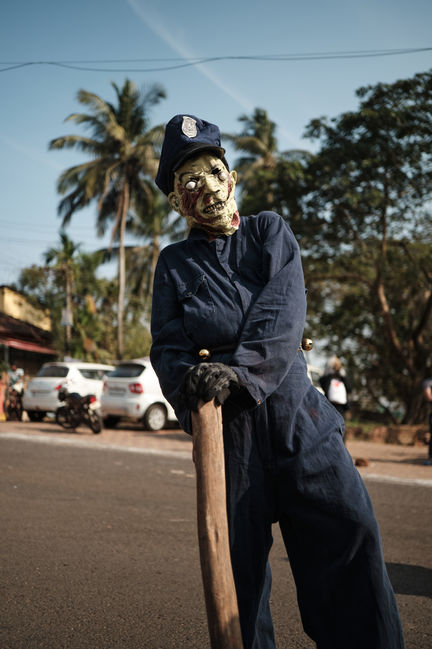Potekaranchem
Locally known as Potekarchem, the Potekar Festival is a vibrant and eccentric tradition celebrated on the riverine island of Divar, nestled near Panjim, Goa. While the festival’s exact origins are cloaked in local folklore and legend, it remains a proud cultural relic for the Diwadkars—the Konkani-speaking residents of the island. Observed over the three days leading up to Ash Wednesday, Potekarchem marks the threshold of Lent in the Christian liturgical calendar. Yet, despite its timing, the festival retains a distinctly secular, community-driven character. The word Potekar literally translates to "shabby," a fitting name given the nature of the costumes and antics that define the celebration. During the festival, young men of Divar don ragged outfits, oversized boots, and elaborate masks—some handmade, others store-bought—and strap cowbells around their waists. These bells serve as audible warnings of their mischievous arrival. Cloaked in anonymity and falsetto voices, the Potekars roam the island, startling residents and passersby, especially children, with harmless pranks. Those deemed gullible may even be coerced into parting with small sums of money. According to one Potekar, the tradition likely began in the mid-20th century as a creative way to instill discipline among the island’s youth. But over time, it has grown into a theatrical and much-anticipated community ritual. Children often bear the brunt of the frightful fun—sometimes to the point of tears—while parents watch, amused and unmoved. In earlier times, the Potekars would continue their antics late into the night, until a collective plea from Divar’s mothers finally curbed their scares after sundown. The disguises are elaborate, often reused and passed from one Potekar to another over the course of the festival. The theatrics are executed with near-professional flair—designed to unsettle, confuse, frighten and entertain. The secrecy of their identities is strictly guarded, in part to maintain the mystique, but also to avoid post-festival backlash from especially terrified victims. The celebration concludes with a lively parade through the island, followed by a communal gathering—one final burst of revelry before Lent’s introspective solitude begins. Divar itself is a world apart from the rest of Goa. With no road connectivity, the island can only be reached by ferry services operating from three weathered ramps. This relative inaccessibility has kept Divar off the radar of most tourists, who often prioritize the state’s beaches, nightclubs, and casinos. Diwadkars have staunchly resisted proposals to build a bridge connecting Divar to the mainland. For them, the lack of a road has preserved the island’s cultural distinctiveness and shielded it from the unchecked tourism that has transformed much of coastal Goa. Over the years, many of Divar’s younger residents have migrated in search of better opportunities. Today, the island is home mostly to pensioners and timeworn houses—some awaiting revival by returning heirs willing to invest in restoration, others likely to be sold off to developers. No matter what lies ahead, the Potekar Festival endures as a powerful reminder of Goa’s layered identity. In a state often associated with sun and sand, Divar’s shabby masqueraders offer a different narrative—one that celebrates indigenous expression, community spirit, and the enduring charm of the offbeat.

















































